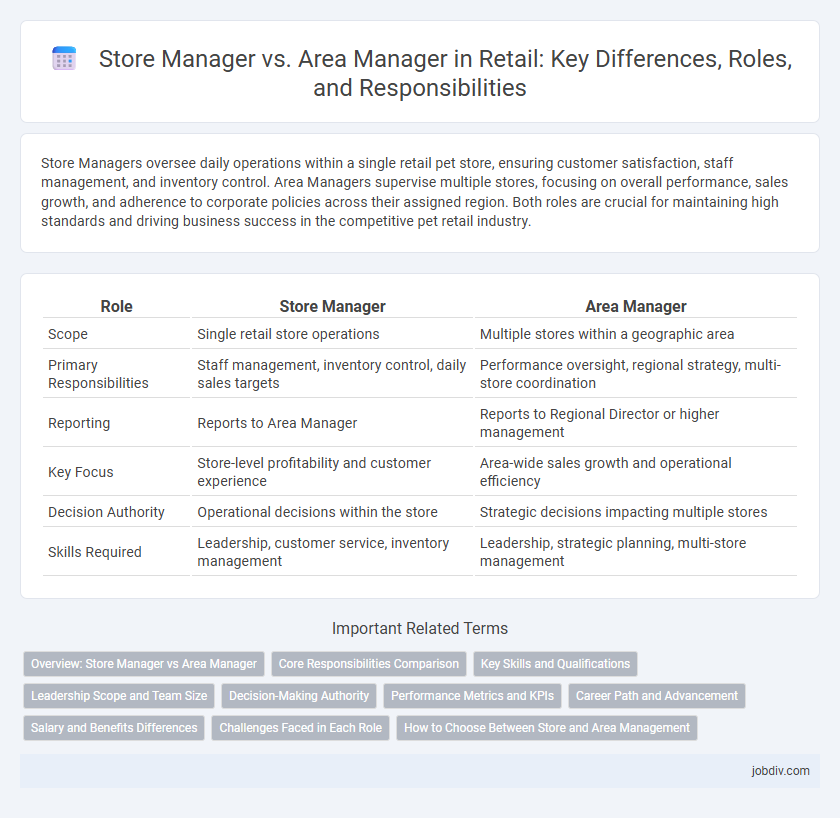Store Managers oversee daily operations within a single retail pet store, ensuring customer satisfaction, staff management, and inventory control. Area Managers supervise multiple stores, focusing on overall performance, sales growth, and adherence to corporate policies across their assigned region. Both roles are crucial for maintaining high standards and driving business success in the competitive pet retail industry.
Table of Comparison
| Role | Store Manager | Area Manager |
|---|---|---|
| Scope | Single retail store operations | Multiple stores within a geographic area |
| Primary Responsibilities | Staff management, inventory control, daily sales targets | Performance oversight, regional strategy, multi-store coordination |
| Reporting | Reports to Area Manager | Reports to Regional Director or higher management |
| Key Focus | Store-level profitability and customer experience | Area-wide sales growth and operational efficiency |
| Decision Authority | Operational decisions within the store | Strategic decisions impacting multiple stores |
| Skills Required | Leadership, customer service, inventory management | Leadership, strategic planning, multi-store management |
Overview: Store Manager vs Area Manager
Store Managers oversee the daily operations and staff performance within a single retail location, ensuring customer satisfaction, inventory management, and sales targets are met. Area Managers supervise multiple stores within a specific region, coordinating between Store Managers to align strategies, enhance overall profitability, and implement corporate directives. Both roles require strong leadership and operational skills but differ in scope, with Store Managers focusing on individual store success and Area Managers driving regional growth and consistency.
Core Responsibilities Comparison
Store Managers oversee daily store operations, including staff management, inventory control, and customer service to ensure smooth in-store performance. Area Managers supervise multiple store locations, focusing on operational consistency, sales targets, and regional strategy implementation across their assigned territory. Both roles require leadership and performance analysis but differ in scope, with Store Managers handling hands-on management and Area Managers driving broader business objectives.
Key Skills and Qualifications
Store Managers excel in team leadership, inventory management, and customer service, requiring strong communication and organizational skills along with a high school diploma or equivalent, often supplemented by retail experience. Area Managers oversee multiple store locations, demanding advanced strategic planning, performance analysis, and leadership capabilities, typically necessitating a bachelor's degree in business or related fields and extensive managerial experience. Both roles require proficiency in sales analytics, staff training, and operational efficiency to drive store performance and achieve business targets.
Leadership Scope and Team Size
Store Managers lead individual retail locations, overseeing daily operations and managing teams typically ranging from 15 to 50 employees. Area Managers provide leadership across multiple stores within a region, supervising several Store Managers and directing a combined team that can exceed 200 employees. The broader leadership scope of Area Managers requires strategic oversight and coordination to ensure consistent performance and customer experience across all stores.
Decision-Making Authority
Store Managers hold direct decision-making authority over daily store operations, staff management, inventory control, and customer service strategies, ensuring immediate responsiveness to local market conditions. Area Managers possess broader decision-making power, overseeing multiple store locations, setting regional performance goals, allocating resources, and implementing standardized policies to align individual stores with corporate objectives. The distinction lies in the scope of influence, with Store Managers focused on tactical execution and Area Managers responsible for strategic oversight across several outlets.
Performance Metrics and KPIs
Store Managers are primarily evaluated on in-store performance metrics such as sales volume, customer satisfaction scores, inventory turnover rates, and employee productivity. Area Managers oversee multiple stores, focusing on aggregated KPIs including total revenue growth across locations, market share expansion, and consistent operational compliance. Both roles utilize performance dashboards and retail analytics tools, but Area Managers emphasize strategic metrics like regional profitability and cross-store benchmarking to drive broader business objectives.
Career Path and Advancement
Store Managers oversee daily operations, staff management, and local sales targets, building essential leadership skills within a single retail location. Area Managers coordinate multiple store teams, implement broader business strategies, and analyze regional sales data, preparing for higher executive roles. Career advancement typically transitions from Store Manager to Area Manager, progressing toward district or regional leadership positions with expanded responsibilities.
Salary and Benefits Differences
Store Managers typically earn a salary ranging from $45,000 to $65,000 annually, with benefits including employee discounts, healthcare, and performance bonuses. Area Managers, overseeing multiple store locations, command higher salaries between $70,000 and $100,000, complemented by more extensive benefits such as company cars, travel allowances, and enhanced retirement plans. The significant salary gap reflects the broader responsibility and strategic oversight Area Managers maintain compared to Store Managers.
Challenges Faced in Each Role
Store Managers face daily challenges such as inventory management, staff scheduling, and ensuring exceptional customer service within a single location. Area Managers handle broader responsibilities including overseeing multiple store performances, aligning regional sales strategies, and managing inter-store conflicts. Balancing operational efficiency with team motivation is critical in both roles, yet scaling these tasks varies significantly between managing one store and an entire district.
How to Choose Between Store and Area Management
Choosing between Store Manager and Area Manager roles depends on your preference for scope and responsibilities; Store Managers focus on day-to-day operations, employee management, and customer experience within a single location, while Area Managers oversee multiple stores, ensuring consistent performance, implementing corporate strategies, and driving regional sales growth. Consider your skills in multitasking and strategic planning, as Area Managers require strong leadership across diverse teams, whereas Store Managers benefit from hands-on operational expertise. Align your career goals with the desired level of accountability and influence within retail management hierarchies.
Store Manager vs Area Manager Infographic

 jobdiv.com
jobdiv.com